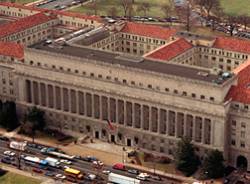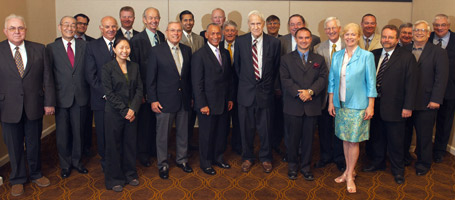
When the nation’s top GPS advisors meet next month they will announce their new chairman — a former defense official, welcome four other new members, and begin with a freshly renewed charter.
When the nation’s top GPS advisors meet next month they will announce their new chairman — a former defense official, welcome four other new members, and begin with a freshly renewed charter.
The National Space-Based Positioning, Navigation, and Timing (PNT) Advisory Board convenes its next session on June 11 in Annapolis, Maryland. The group — which comprises more than two dozen nongovernmental members from industry, academia, and international organizations — provides the U.S. government advice on policy, planning program management, and funding. They have taken on issues of the GPS constellation’s design, the impact of GPS on the American economy, the use of international GNSS signals within the United States, and how to protect GNSS signals from interference and jamming.
The board’s new chair, John Stenbit is an expert on telecommunications and command and control with over three decades of experience in both the defense and private sectors. Described as a real gentleman by one former associate, he has served as assistant secretary of defense for command, control, communications, and intelligence (C3I) and in the same role when the office was redesignated networks and information integration (NII). He has also served as the Department of Defense’s chief information officer, making him a key player in GPS-related decisions.
NASA Administrator Charles Bolden renewed the group’s charter on May 8, extending its operations for another two years and underwriting its roughly $160,000 annual budget. NASA will continue to provide organizational support to the group. Jim Miller, the deputy director for Policy & Strategic Communications – Space Communications and Navigation within NASA’s Human Exploration and Operations Mission Directorate is the space agency’s designated federal officer for the board.
The board’s new chairman has industry experience as well. Stenbit was an executive vice-president of TRW, from which he retired in May 2001 and prior to that held a position with the Aerospace Corporation involving command and control systems for missiles and satellites, and satellite data compression and pattern recognition.
Stenbit has served on a wide variety of boards. He chaired the Science and Technology Advisory Panel to the director of Central Intelligence and served as a member of the Science Advisory Group to the directors of Naval Intelligence and the Defense Communications Agency. He also chaired the Research, Engineering and Development Advisory Committee for the administrator of the Federal Aviation Administration and has served on the Defense Science Advisory Board (where he is still a member), the Navy Studies Board, and the National Research Council Manufacturing Board. He is currently a member of the National Security Agency Advisory Board, the STRATCOM Advisory Board, and the National Reconnaissance Office Advisory Group and is a director at Viasat, Defense Group Inc., and Loral Space and Communications.
“I am excited to be able to contribute once again to the preservation and enhancement of these vital capabilities,” Stenbit told Inside GNSS. “I have not been involved in the details for a few years,” he said in an email, “but am certain the continuing issues of spectrum allocation, interference characterization and mitigation, and effective use of the capabilities of augmentation systems and those of other countries will still be important. I look forward to seeing the new issues and begin to work on them.”
Stenbit will take up the gavel in October when the group meets in Boulder, Colorado, just prior to the International Committee Meeting on GNSS.
Other New Members
Joining the board for the first time in June will be Scott Burgett, the director of Global Navigation Satellite Systems for Garmin International. He is responsible for the design, evaluation, integration, and proper function of GPS technology in Garmin consumer devices.
Burgett started his career at Sandia National Laboratories where he worked on the integration of GPS with inertial navigation systems. He joined Garmin in 1998, conducting early research into wearable GPS technology. He played a key role in the creation of turn-by-turn automotive navigation systems combining GPS and dead reckoning technology and has contributed to the development of certified aviation equipment.
New board member Lt. Gen. Larry D. James, previously served as the GPS program manager. Now retired from the Air Force, he is deputy director of the Jet Propulsion Laboratory where he is responsible for the day-to-day operations.
James was the Air Force deputy chief of staff for Intelligence, Surveillance and Reconnaissance at the Pentagon. He also served on the staffs of U.S. Space Command, Air Force Space Command, and at Air Force headquarters — he even did a turn as a Space Shuttle payload specialist. James was the director of Space Forces for Operation Iraqi Freedom at the Combined Air Operations Center, Prince Sultan Air Base, Saudi Arabia.
Dana Goward, the founder and executive director of the Resilient Navigation & Timing Foundation, will also join the board in June. He previously served as the maritime navigation authority for the United States. As director of Marine Transportation Systems for the U.S. Coast Guard, he led 12 different navigation-related business lines budgeted at over $1.3 billion a year. A retired Coast Guard captain, Goward is also a licensed helicopter and fixed wing pilot and has served as a navigator at sea.
The Coast Guard ran the old Loran positioning system and now, as head of the RNT Foundation, Goward advocates for adoption of enhanced Loran or eLoron as a backup system for GPS in the United States — a position strongly supported by the PNT board.
Sergio Camacho-Lara, the secretary general of the United Nations Regional Education Center of Science & Space Technology for Latin America and the Caribbean, will join the board as an international representative. He was director of the United Nations Office for Outer Space Affairs (UNOOSA) from 2002 to 2007 and also served as the chief of the Committee Services and Research Section, secretary for the Scientific and Technical Subcommittee of the Committee on the Peaceful Uses of Outer Space (COPUOS), and chief of the Space Applications Section. Prior to that he was a researcher at the Instituto de Geofisica, Universidad Nacional Autonoma de Mexico (UNAM).





